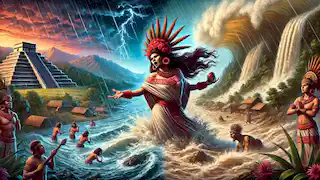In the ancient lands of the Mexica, the Aztec people believed the world was shaped by powerful gods who watched over humanity with a mixture of love, wisdom, and sometimes fierce wrath. One such deity was Chalchiuhtlicue, the goddess of rivers, lakes, and all earthly waters, revered as the "She of the Jade Skirt." Her flowing green robes represented life-giving rivers, while her gentle, yet commanding presence symbolized the essence of water’s dual nature—nourishing yet capable of overwhelming destruction. The legends surrounding her were tales of compassion and strength, intertwined with the eternal flow of rivers, mirroring the lives and deaths that unfolded along their banks.
It was said that Chalchiuhtlicue had the power to govern the life within waters and, at times, was called upon to bring rains for harvests or floods for purification. Yet, hers was a tale of sacrifice, responsibility, and the ever-revolving balance of creation and destruction. This is her story, one that echoes through the lakes, rivers, and rain-soaked jungles of ancient Mexico—a legend cherished by the people who saw her reflection in the vibrant waters around them. Long before Chalchiuhtlicue came into the world, there was Tlaloc, the god of rain, thunder, and fertility. Tlaloc’s thunderous voice commanded the skies, and his rains poured forth, nourishing the earth. However, there came a time when Tlaloc sought companionship and found it in the serene and beautiful Chalchiuhtlicue, who captivated him with her compassion for all beings. Chalchiuhtlicue shared Tlaloc’s love for creation and possessed an unmatched empathy for those who depended on water to survive. Together, they became guardians of the earth's waters, balancing life through gentle rains and the rivers that carved through the land. In her own right, Chalchiuhtlicue was powerful. Her jade-green dress shimmered like the light on water, symbolizing purity and the interconnectedness of life. The people worshiped her, building shrines along the rivers and lakes where they offered jade stones and delicate feathers as symbols of respect. But Chalchiuhtlicue was no distant figure; she was seen as a nurturing force, a goddess who watched over mothers, children, and all who needed shelter from life’s hardships. Yet, not all looked upon Chalchiuhtlicue with admiration. Some feared her, believing her powers could bring torrents of rain that would flood their fields and villages, washing away crops and homes. They saw her beauty and kindness as veils that hid a stormier nature, one that could unleash devastation without warning. It was during one of the hottest seasons that the villages began to suffer greatly. The rivers that once flowed with crystal clarity had dried, the lakes had receded, and the people’s hope was withering under the sun’s relentless gaze. The farmers prayed to Tlaloc, but it seemed their cries went unanswered, the skies remaining unyielding and barren. It was Chalchiuhtlicue who first heard the people’s laments as she walked along the dry riverbeds, feeling the earth crack beneath her feet. Driven by her boundless empathy, Chalchiuhtlicue knew she had to intervene. She approached Tlaloc, her husband, with a plea. “Tlaloc,” she said, her voice gentle yet firm, “the people are suffering. Their rivers and lakes are nearly gone. They have shown their devotion to us; it is our duty to answer them in their time of need.” Tlaloc, however, was cautious. “If I open the heavens for rain, I risk losing the balance. Too much rain, and they will curse us for bringing floods.” Chalchiuhtlicue understood his concern, but her compassion outweighed her fears. She offered to be the one to provide the rains, to go forth and pour out her energy and love for the people into the rivers. Tlaloc, seeing the depth of her resolve, agreed and watched as Chalchiuhtlicue turned her radiant gaze upon the land. As Chalchiuhtlicue opened herself to the world, the skies darkened, and a gentle rain began to fall. The rivers, once dry, began to fill, and lakes shimmered under the revitalizing droplets. Life returned to the fields, and the people rejoiced, celebrating the return of water and life. But with this act came a price. As Chalchiuhtlicue gave herself to nourish the land, she felt her energy waning. Her jade dress dimmed, and her once-bright aura grew faint, as if the very life within her was draining away. The people saw this, and they realized the goddess had given much for them. Out of gratitude, they redoubled their offerings, vowing to honor her selflessness and the precious gift of water. Years passed, and Chalchiuhtlicue’s act of kindness was remembered fondly by those she had saved. Yet, as generations moved on, the people’s memories began to fade. They grew complacent, and some even took her gifts for granted, neglecting their worship and failing to respect the waters. Seeing this, the other gods grew angered. They felt the people were becoming arrogant, that they needed a reminder of the gods' power and the importance of respect. Chalchiuhtlicue, however, pleaded for mercy on behalf of the people, remembering her bond with humanity. In a divine council, it was decided: Chalchiuhtlicue herself would be the one to teach them this lesson. Though it grieved her to bring harm, she understood that this was a chance to renew their devotion and respect for the sacred waters. And so, with a heavy heart, Chalchiuhtlicue unleashed her power, causing the rivers to overflow and the skies to pour without ceasing. The rains became a deluge, and the earth drank deeply, to the point where fields and homes were consumed by the flood. The people, seeing their villages engulfed by water, were reminded of the fragility of life and the wrath of the gods they had once revered. Yet, even in the midst of the flood, Chalchiuhtlicue’s love for them shone through. She allowed pockets of safety—small islands untouched by the waters—where the people could gather and pray, reigniting their devotion and humility. Those who understood the message were spared, their faith renewed, while those who continued to doubt were swept away by the merciless currents. In the end, the floodwaters receded, leaving the land washed clean, fertile, and ready for a new beginning. The people rebuilt their lives, this time with greater reverence for Chalchiuhtlicue and a newfound understanding of the delicate balance they shared with nature. The legend of Chalchiuhtlicue endured through the centuries. Her story became a tale of compassion and respect, teaching future generations the importance of gratitude and reverence for the natural world. Every lake, river, and raindrop was seen as a blessing, a reminder of the goddess who had given so much for their survival. People would gather along the riverbanks to tell the story of how Chalchiuhtlicue’s love saved their ancestors, even as her power warned them of nature’s strength. Festivals were held in her honor, where they tossed jade stones into the water, symbolizing their connection to the goddess and their unbreakable bond with the element that sustained them. In time, the legend of Chalchiuhtlicue became a part of the soul of the land, as intrinsic to the culture as the rivers themselves. Her story was no longer just about a deity but about the enduring relationship between humanity and the waters that give them life. Each new generation grew up hearing of her compassion and strength, vowing to live with respect and care for the world around them. In the realm of the gods, Chalchiuhtlicue continued to watch over her people from her seat among the stars, her jade skirt flowing like the rivers she so dearly loved. She had passed her trials, learning that compassion sometimes required strength, and that to truly love humanity meant guiding them through the good and the hardships alike. It is said that on moonlit nights, if one looks closely into a still lake or river, they might see a glimpse of Chalchiuhtlicue's jade reflection, a silent reminder of her presence. She is always there, in every stream and raindrop, the eternal mother watching over the earth. And so, the legend of Chalchiuhtlicue endures, whispered among riverside fires and sung in the gentle rustling of leaves over water. Her story remains a testament to the balance of life, love, and the ever-flowing spirit of water—a legacy forever imprinted in the heart of Mexico.The Origins of Chalchiuhtlicue

The Test of Compassion
The Great Flood and the Test of Devotion

Chalchiuhtlicue’s Legacy

The Eternal Watch




















